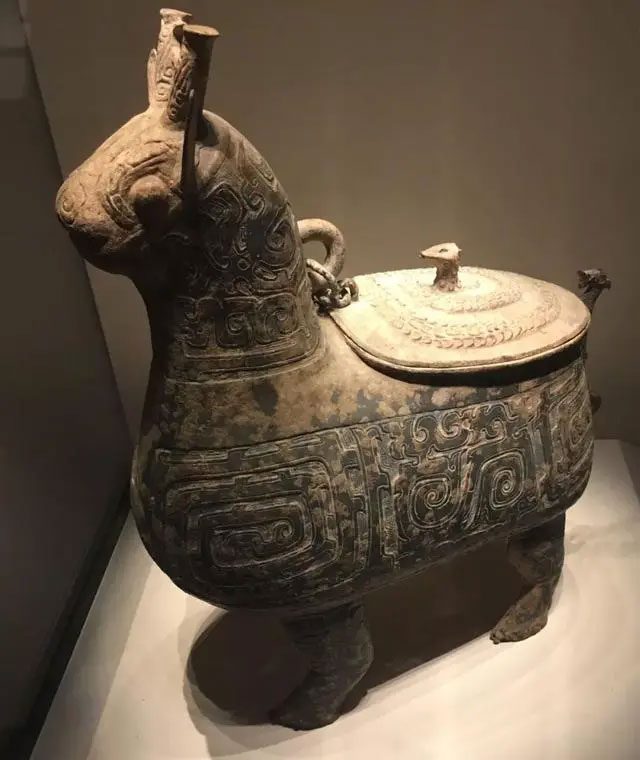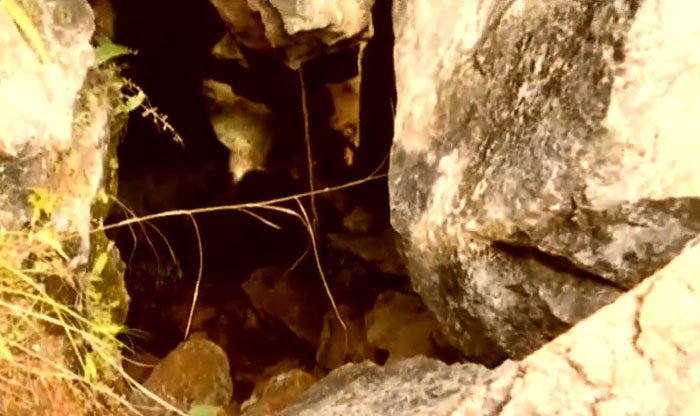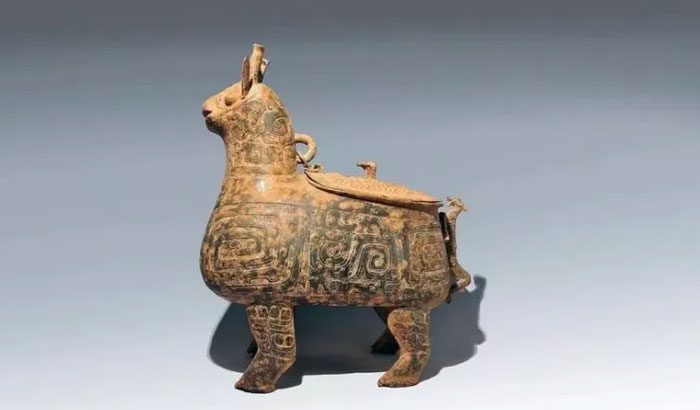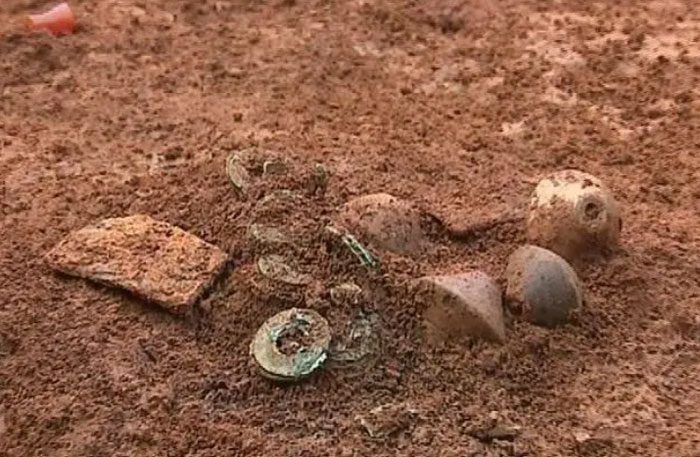A routine chase leads to the discovery of a valuable treasure. This is a true story from Guangxi Province, China.
In July 1991, an elderly farmer named Tran Hai Quy from Long Trung village, Sa Dien town, in Ha Zhou city (Guangxi Province), was frustrated to find that his peanut plants were being ravaged by animals just before harvest. Despite trying various methods, the situation did not improve.
One night, Tran finally identified the “culprit” destroying his peanut crops: a pack of foxes.
Tran was puzzled as to why these foxes were eating his peanuts. He grabbed a hoe and rushed towards them, causing the foxes to flee in fear. They quickly vanished, leaving only the trace of one fox. Tran chased after it but, as it was late, he hesitated to venture deeper into the mountains. However, he saw the fox slip into a cave in the cliff and disappear. Upon reaching the spot, he blocked the cave entrance with a stone, marked it, and decided to go back down the mountain.
The next day, Tran Hai Quy called his son and a villager to follow the traces from the previous night to the mountainside to find the fox’s den. The three of them brought flashlights and some other tools.
When they arrived, the inside of the cave was pitch dark, with slippery walls and uneven ground. Fortunately, all three had flashlights, allowing them to navigate deeper into the cave. On the stone walls of this cave, there were signs of human intervention. This cave appeared to have been formed artificially.
As Tran shone his flashlight deeper into the cave, he was startled to see something unusual. At first, he thought it was a fox and intended to teach the creature a lesson with his hoe. However, upon closer inspection, he realized it was not a fox or a living creature at all. Instead, it was a large, ancient bronze vessel.
This ancient vessel was peculiar, featuring a horned head, looking very strange.

The oddly shaped bronze vessel found in the fox’s cave.
Feeling that the vessel in the fox’s den might be a treasure, the three men did not dare to go further into the cave. Tran brought the vessel back to his village at the foot of the mountain.
The news of Tran’s discovery of the strange vessel quickly spread through the village. At this time, a group of relic and antique traders approached him and bluntly asked: “800,000 yuan, will you sell it?“.
In the early 1990s, 800,000 yuan (around over 2.6 billion VND) was a significant amount of money. Despite the tempting offer, Tran hesitated to sell. Later, another group came to inquire about buying the vessel. At this point, Tran believed the vessel he found in the fox’s den could be a valuable treasure, as it attracted so many antique traders. Consequently, the farmer decided not to sell it.
While Tran was unsure what to do with the ancient vessel, news of his find spread and caught the attention of cultural heritage officials and experts.
Guided by local villagers, experts located Tran Hai Quy and engaged him in discussions. After listening to the experts, Tran decided to reveal the vessel. When the experts saw the bronze vessel, they were amazed and asked Tran where he found it.
Tran sincerely recounted the details of how he discovered this unique bronze object. Upon finishing, the experts laughed and joked: “We should thank that fox!“.
Who is the owner of the ancient vessel?

This mysterious cave is actually an ancient tomb dating back approximately 2,500 years.
It is impossible for an object made of bronze like this to have naturally appeared in a cave. Archaeological experts speculate that there must be some hidden secrets within this cave.
With the guidance of Tran Hai Quy and others, experts located the mysterious cave. While no foxes were found, at the spot where Tran discovered the bronze vessel, investigations revealed that this was actually an ancient tomb from the Warring States period, around 2,500 years old.
The experts immediately began excavation inside the cave. As a result, they discovered 33 valuable cultural relics, including many bronze items, pottery, and cowrie shells.
However, the most precious item in this fox’s den was the strangely shaped vessel that Tran had found.

This ancient vessel is regarded as a rare masterpiece in the archaeological world.
Despite the exterior of the vessel being covered in rust, it does not obscure its simple yet dignified and exquisite shape. Notably, experts observed that the carving art on the vessel was extremely skilled, with intricate and lively patterns.
The ancient bronze vessel stands approximately 53.7 cm tall, 28 cm long, and weighs 21.5 kg, featuring a unicorn-shaped head, with a relief carving of a reclining dragon, and a tail attached to a phoenix. The body has many exquisite and unique patterns. These details showcase the exceptional craftsmanship of ancient artisans.
The combination of three mythical creatures—dragon, phoenix, and unicorn—on a single vessel illustrates that this is a rare masterpiece in the archaeological world.
Most experts agree that this is the first time that the three mythical creatures—dragon, phoenix, and unicorn—have been combined on the same vessel. The decoration with such mythical creatures indicates that the owner of this ancient vessel held a very high status.
With the assistance of experts from the National Museum, it has been unanimously concluded that the owner of this unicorn-shaped vessel was a noble during the Warring States period.
This unicorn-shaped vessel was used for holding fine wine. Furthermore, according to the curator of Ha Zhou Museum, this bronze vessel was also a ceremonial object used during major sacrificial events. To date, this is the only bronze vessel combining the mythical creatures—dragon, phoenix, and unicorn—found in China.
According to experts, the discovery of such a finely crafted vessel in Ha Zhou indicates that there was extensive cultural exchange in this area.
The ancient vessel becomes a national treasure

Thanks to the ancient vessel, experts have uncovered many cultural relics in Ha Zhou city.
Moreover, the discovery of this vessel acted as a key that helped experts unlock a treasure trove of cultural relics buried beneath the earth for thousands of years in Ha Zhou. Specifically, after expanding the investigation and excavation scope, within a few months, Ha Zhou Museum managed to seize over 30,000 cultural relics.
Although Tran and other villagers voluntarily submitted the cultural relics without requesting any rewards, the local cultural heritage agency awarded each of them a certificate of appreciation and a cash reward of 200 yuan.

The unicorn-shaped vessel is currently preserved at the National Museum of China.
The bronze unicorn-shaped vessel has been recognized as a national treasure of China. This treasure has been displayed in various locations across the country since 1993. Additionally, the vessel has been exhibited in several countries around the world, including Denmark, France, the Netherlands, and many other European nations. The ancient vessel is now housed at the National Museum of China.
- While fishing in the river, a farmer accidentally scooped up a “national treasure” turtle “mysteriously” with four arrows stuck in its back
- Stunning discovery in an ancient tomb at the San Lorenzo Basilica
- The mysterious ‘national treasure’ that once became a frying pan, a boy bought it for 300 USD, only to find out it was worth over half a ton of gold


















































